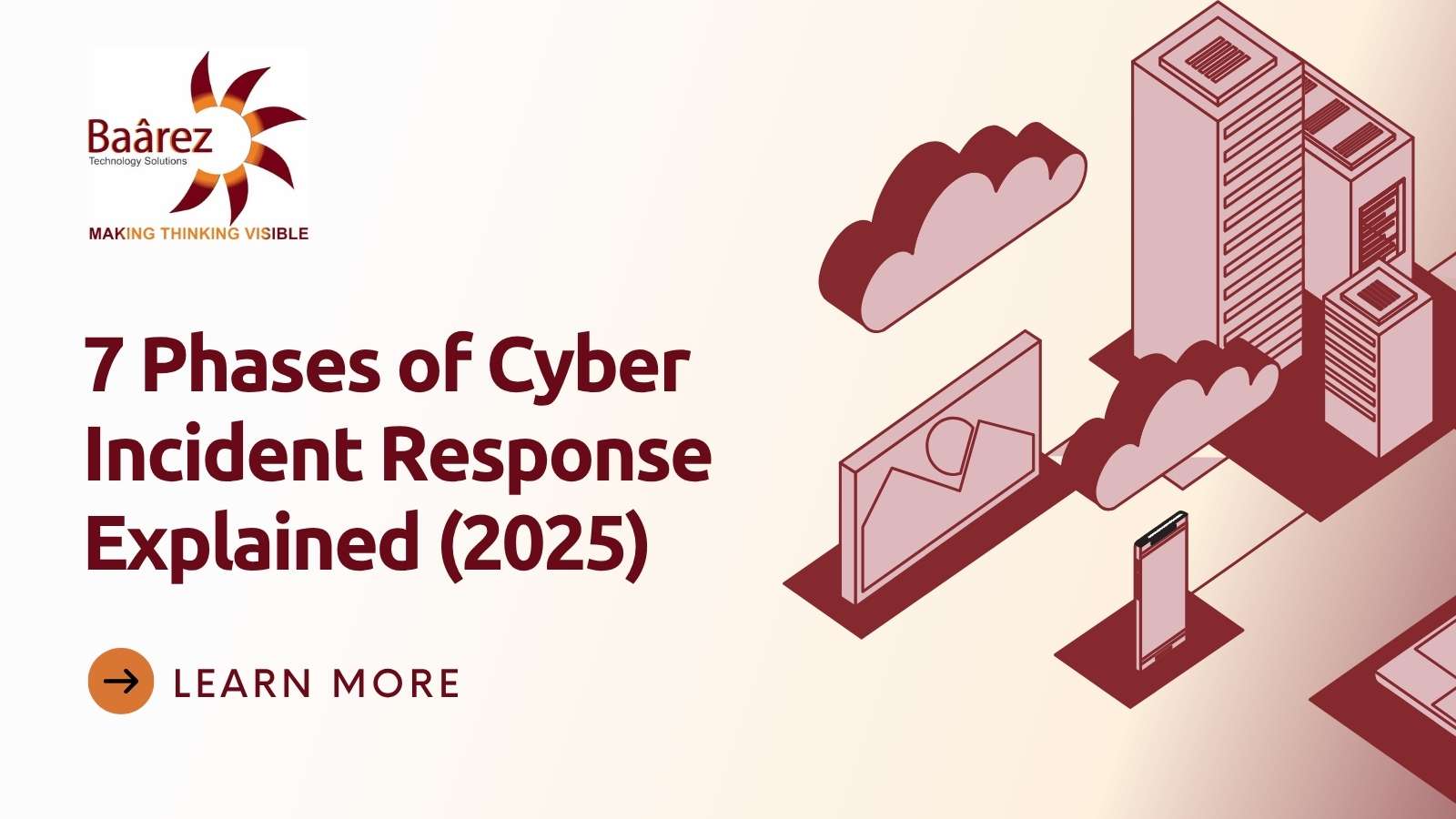
In today’s digital-first world, cyber threats are more advanced, persistent, and disruptive than ever before. Organizations need a clear and structured approach to managing security incidents. That’s where the 7 phases of cyber incident response come into play. These phases help IT teams quickly detect, contain, and recover from cyberattacks while minimizing damage and downtime.
Whether you’re a small business or a global enterprise, understanding and implementing a robust incident response plan is critical for survival in 2025’s cybersecurity landscape.
In this guide, we break down the seven phases of cyber incident response and explain how each step helps you stay resilient and secure.
Table of Contents
TogglePhases of Incident Response
The incident response lifecycle is a structured approach to managing cybersecurity incidents. It is designed to:
- Minimize the impact of security breaches
- Ensure a fast, effective response
- Prevent similar incidents in the future
The 7 phases of incident response are:
Phase Number | Phase Name | Primary Objective |
1 | Preparation | Strengthen security posture before an incident |
2 | Identification | Detect and confirm a cybersecurity event |
3 | Containment | Isolate the threat and limit its spread |
4 | Eradication | Remove the cause and artifacts of the incident |
5 | Recovery | Restore systems and resume business operations |
6 | Lessons Learned | Review the response and improve future readiness |
7 | Communication | Inform stakeholders, regulators, and users |
These phases are not strictly linear. Some may overlap or repeat, especially in complex or ongoing attacks.
1. Preparation: Building a Security-First Culture
The Preparation phase is the foundation of any successful cyber incident response strategy. Without it, even the most advanced detection tools and skilled responders may fail. This phase is all about being proactive rather than reactive.
A strong security posture begins long before an incident ever occurs. It involves training, planning, and putting the right tools and teams in place to respond effectively.
Key Objectives of the Preparation Phase:
- Build a cybersecurity-aware culture
- Develop and update the incident response plan (IRP)
- Define roles and responsibilities
- Implement necessary tools and technologies
- Conduct regular training and simulations
Tips to Build a Security-First Culture
- Establish clear policies on data use, remote access, and password hygiene
- Perform tabletop exercises to simulate attack scenarios
- Review and update the IRP at least quarterly
- Involve leadership in security discussions and decisions
- Monitor security trends and tailor training based on emerging threats
By taking time to prepare, your organization gains the upper hand when a cyber incident does occur. You reduce chaos, speed up response times, and protect valuable data and assets.
2. Identification: Detecting and Confirming the Incident
The Identification phase is where the response process begins in real time. This is the moment when a potential security breach is detected, investigated, and confirmed as a true incident.
Early detection is critical. The faster an incident is identified, the quicker your team can act to contain and mitigate it. Delays at this stage often lead to widespread damage and data loss.
Goals of the Identification Phase:
- Recognize unusual or unauthorized activity
- Confirm whether it is a real security incident
- Determine the type, scope, and severity of the threat
- Begin documenting everything for analysis and reporting
Tools Used for Identification
- SIEM (Security Information and Event Management)
- Intrusion Detection Systems (IDS)
- Endpoint Detection and Response (EDR)
- Log monitoring tools
- Threat Intelligence Platforms
Best Practices
- Define what constitutes a security incident to avoid false alarms
- Set up alert thresholds to spot anomalies quickly
- Ensure real-time monitoring is in place for critical systems
- Create escalation protocols so incidents reach the right people fast
The identification phase ensures that every alert is treated with the right level of urgency. It sets the stage for containment, helping teams respond precisely and efficiently.
3. Containment: Stopping the Spread
Once an incident is confirmed, the next priority is containment — stopping the threat from spreading further across the organization’s systems. This phase is all about damage control.
Containment is critical because it buys time for the response team to analyze the situation, remove the threat, and begin recovery. It must be handled with care to avoid alerting the attacker or causing unnecessary disruption to business operations.
Goals of the Containment Phase:
- Limit the attacker’s movement within the network
- Isolate affected systems and devices
- Preserve evidence for investigation
- Maintain business continuity as much as possible
There are two types of containment: short-term and long-term. Both are essential for a well-rounded response.
Short-Term Containment
This is the immediate response to halt the attack in progress.
Short-Term Containment Tactics:
- Disconnect compromised systems from the network
- Disable affected accounts or services
- Block malicious IP addresses or domains
- Change credentials for potentially compromised users
- Redirect traffic or shut down vulnerable interfaces temporarily
Long-Term Containment
Once the immediate threat is halted, it’s time to implement more sustainable strategies to prevent reinfection and further access.
Long-Term Containment Strategies:
- Apply security patches and system updates
- Reconfigure firewalls and access rules
- Segment networks to contain threats to smaller areas
- Enhance monitoring of affected systems
- Begin a forensic investigation
Strategy | Outcome |
Patch vulnerabilities | Closes the doors the attacker used |
Increase access restrictions | Limits lateral movement |
Network segmentation | Isolates critical systems from general traffic |
Both containment phases ensure that the incident does not escalate further and that the environment is secure enough to proceed to eradication and recovery.
4. Eradication: Eliminating the Root Cause
After containment has stopped the threat from spreading, the next crucial step is eradication — completely removing the attacker, malicious code, and any backdoors or vulnerabilities used during the incident.
This phase ensures that the threat cannot re-emerge and that the environment is safe for recovery and continued operations.
Key Goals of the Eradication Phase:
- Remove malware, ransomware, or malicious files
- Identify and patch exploited vulnerabilities
- Eliminate attacker persistence (e.g., backdoors, rogue accounts)
- Confirm that all traces of the threat are gone
Important Considerations
- Be thorough. Missing even one malicious file or backdoor can lead to reinfection.
- Document everything. This helps in forensic analysis and legal compliance.
- Collaborate with vendors or law enforcement if the breach involves third-party software or criminal activity.
Eradication isn’t just about deleting files — it’s about making sure the entire root cause of the breach is understood and removed. This creates a clean slate for the recovery process that follows.
5. Recovery: Restoring Normal Operations
Once the threat has been eliminated, it’s time to restore systems and services to full functionality. The Recovery phase is about bringing your business back to normal—safely and securely.
This step must be handled with caution. Restoring too soon can risk reintroducing the threat, while waiting too long can affect business continuity and user trust.
Objectives of the Recovery Phase:
- Validate the integrity of restored systems
- Monitor systems for signs of lingering threats
- Reconnect systems to the production environment
- Restore data from verified, clean backups
- Resume normal business operations
Recovery Checklist
- Are systems fully patched and hardened?
- Have user credentials been reset?
- Has malware been completely removed?
- Are all logs being monitored closely?
- Have all systems been tested in a sandbox environment?
Best Practices
- Stage the recovery process — don’t bring everything online at once
- Verify the integrity of all restored data
- Continue monitoring even after going live
- Communicate clearly with internal and external parties
The recovery phase is not just technical—it’s strategic. It’s the bridge between crisis and stability. How smoothly your organization recovers can affect everything from reputation to regulatory compliance.
6. Lessons Learned: Institutionalising Experience
After the dust settles, the Lessons Learned phase allows your organization to turn a painful incident into a valuable learning experience. This phase is often skipped — but it’s one of the most important steps in building long-term cyber resilience.
The goal is simple: analyze what happened, what went wrong, what went well, and how to improve.
Objectives of the Lessons Learned Phase:
- Review the incident response process end-to-end
- Identify gaps, delays, or miscommunications
- Update policies, procedures, and security controls
- Apply improvements to the Incident Response Plan (IRP)
- Strengthen overall incident readiness
Output: The After-Action Report
This report serves as a formal record of the incident and the response. It should be shared with executives, IT teams, and compliance officers.
Contents of an After-Action Report:
- Incident summary
- Timeline of events
- Root cause analysis
- Lessons learned
- Recommendations for improvement
By institutionalizing these lessons, your organization can evolve and mature its cybersecurity posture, becoming better prepared for the next incident.
7. Communication
Effective communication during and after a cyber incident is just as critical as technical response efforts. Clear, timely, and transparent communication can help minimize confusion, reduce damage to your reputation, and ensure compliance with legal and regulatory requirements.
Many organizations underestimate this phase, but it plays a pivotal role in maintaining trust — with customers, employees, partners, and stakeholders.
Objectives of the Communication Phase:
- Keep internal teams aligned and informed
- Notify stakeholders and affected parties
- Fulfill legal and regulatory reporting obligations
- Manage public relations and media narratives
- Support post-incident recovery and reassurance
Tips for Effective Communication During a Cyber Incident
- Be honest but cautious — don’t speculate on unconfirmed details
- Coordinate with legal and compliance teams
- Use multiple channels (email, press releases, web banners, support pages)
- Offer support — provide FAQs, credit monitoring, or a helpline if needed
- Post-incident follow-up — explain improvements and preventive measures taken
Good communication reduces panic, builds trust, and ensures that everyone knows their role and what to expect throughout the incident response lifecycle.
Closing Thoughts
The 7 phases of cyber incident response provide a structured framework to handle security breaches with speed, confidence, and clarity. Each phase — from preparation to communication — contributes to a faster response, less damage, and a stronger organization in the long term.
Organizations that take these steps seriously will be better positioned to face the growing threats of 2025 and beyond.
How Baarez Technology Solutions will Help
At Baarez Technology Solutions, we understand that cyber threats are no longer a question of if, but when. That’s why our Cybersecurity Consulting Services are designed to support organizations across all 7 phases of cyber incident response — from preparation to communication.
Our team of experts brings deep industry knowledge, proven methodologies, and advanced tools to help you detect, respond to, and recover from cyber incidents efficiently.
Why Choose Baarez?
- Proactive Security Approach
We don’t just react — we help you build a resilient, security-first organization. - 24/7 Incident Response Support
Our team is always ready to act, minimizing downtime and impact. - Compliance Expertise
We help you meet regulatory requirements such as GDPR, HIPAA, ISO 27001, and more. - Tailored Solutions
Every organization is unique. Our solutions are custom-fit to your infrastructure, size, and risk profile.
Ready to Strengthen Your Cyber Resilience?
Partner with Baarez Technology Solutions and get ahead of cyber threats with a complete, end-to-end incident response strategy.
Contact us today to learn how we can support your organization across all seven phases of cyber incident response.


